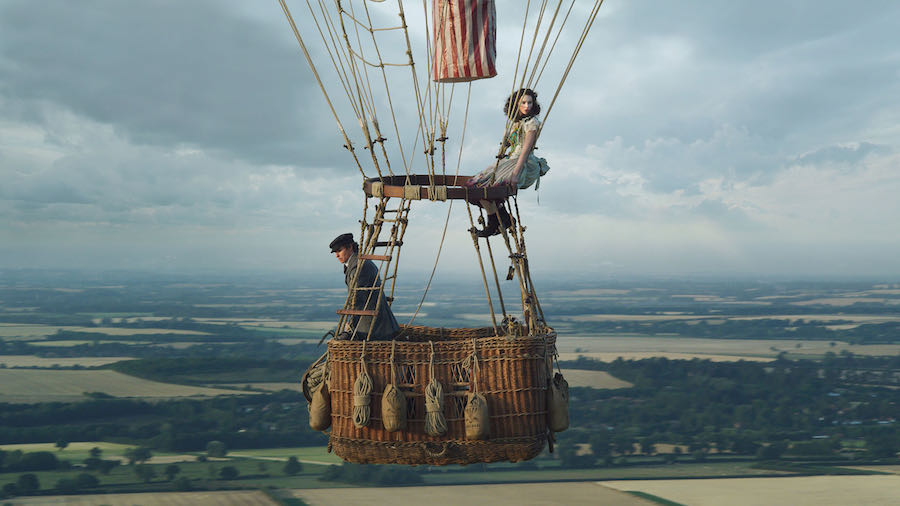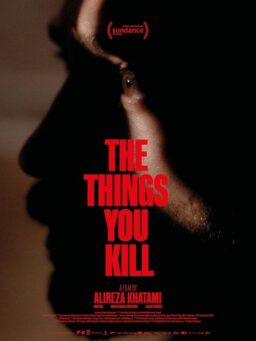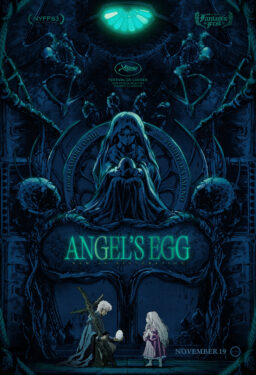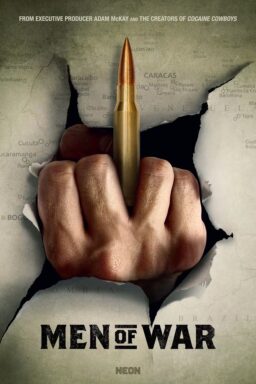Tom Harper’s “The Aeronauts” takes you high into the sky and back to a scientific breakthrough, all within the confines of a hot air balloon basket. It’s 1862, and a balloon pilot named Amelia Wren (Felicity Jones) has teamed up with meteorologist James Glaisher (Eddie Redmayne) to venture higher than anyone has in the past. As they rise to where no man has gone before, the conditions become deadlier, the threat of death even more staggering. Based on true pioneers and their wild achievements, “The Aeronauts” has the presentation of a period piece but the pulse of a deathgrip-your-armrest thriller, especially the many times it looks like our science heroes could drop from the sky.
Wren and Glaisher’s journey into the clouds was created with a seamless mix of in-studio work and real-life, in-air stunt ingenuity. It’s the type of movie that has real stakes baked into its very production, while flourishing from its two strong lead performers (reuniting after the Oscar-winning film, “The Theory of Everything.”)
The day after “The Aeronauts” was screened in October at the Chicago International Film Festival, Harper spoke with RogerEbert.com about the incredible process of making the story, the different ways he pushed Jones and Redmayne, and more.
What was one thing with all the science and history of the story that you wanted to get right the most?
I think there were two things, one sort of visual, one sort of conceptual. On a conceptual level, I think it was wanting to get the sense that these people were trying to genuinely expand the knowledge of the world for the better of humankind. Reading about a number of these balloon flights, it comes up again and again, and I found that incredibly inspiring.
On a visual level, I just wanted to really capture what it was like to fly and to be in a gas balloon, and to make it feel as real as possible. Obviously, the film is slightly heightened, most of what happens in the film does happen but it doesn’t all happen in the same flight. So there is a little bit of artistic license there. But within the confines of that, I wanted it to feel like you were going up 6,000 feet.

What’s the closest you got to experiencing what that would be like?
Well, we built our own balloon, and we flew up in it. Felicity climbed out of it, and we had a stunt woman climb out of the basket and climb up the side of the balloon at 3,000 feet over the English countryside. So we did it, and we filmed it. I obviously didn’t do it myself, but I’d certainly got the feeling of it.
I want to ask about the insurance in making this movie, but I feel like we could talk about that for hours.
There was, I think we were all surprised at how willing they were to insure us [laughs]. But you know it’s all about risk litigation, isn’t it? Our stunt team was so experienced, and so good at what they did, they were able to demonstrate clearly how they had three different failsafes in case something went wrong, and what they were going to do in certain scenarios. With statistics, you can get quite … like how often the balloons have crashed. Very rarely. And so actually, it was pretty straightforward.
How much of the balloon flight footage was SFX? What was practical?
Without meaning to be evasive, it’s genuinely really hard to say. Each shot has elements of both, and it changed all of the time. And to give you an example, the shot above London when they go for the first time, and it pans out and sweeps around. We did shoot that for real, in a helicopter, with Felicity sitting on the hoop of the basket, with them 2,000 feet in the air. That is real, on one level. Of course then, the ground is all 21st century, so the visual effects have to get around that. And then she was in a harness, we had to paint that out. Even the stuff when they’re at 3,600 feet, we couldn’t take them at 3,600 feet. But much of the clouds that we used, there’s a whole massive operation that we did, to get the best clouds. We filmed all of that with this 360-degree camera, so that the clouds are real, and elements of [the actors] are real, because they’re in the basket. But actually, a lot of that is everything you’re seeing is real. And then there are other examples, so it’s just a real combination of different techniques.
How many times do you think you were up in the air, filming this?
Quite a lot, actually. I tried not to do it too much, because helicopters give me the heebie-jeebies.

But you made a flight movie!
Yeah. I know [laughs]. But balloons are fine! It makes sense. If your pilot of a balloon has a heart attack, to go down, you let out air. To go up, you let out sand. It’s pretty straightforward. I’ll give that a go. Whereas with a helicopter, if shit hits the fan, you’re fucked! We did lots of flying in advance of the film because I wanted all the crew members to experience what it was like to fly, so we did some flying then. That was a hot-air balloon, which is much cheaper and more practical. But gas balloons are much harder to come by, and the way you do it if you’re making a film is that you use hydrogen, which is cheaper but also highly explosive, which makes it less desirable.
But I couldn’t go up because of the weight. But I was in a helicopter.
So you’re in a helicopter, watching a balloon, and you’re trying to direct.
We did it like a play, because I couldn’t give notes. But it is limiting to an extent, because we were never able to do it without a helicopter nearby, and that was limiting in terms of what you can do with sound. But we did it where you rehearse a scene on the ground, and we’d give notes, and we’d get it to a level where we were happy, and up they’d go. And they’d do it again, and do it again.
In what ways do you think you pushed Felicity and Eddie? Or what ways did you have to pull them back?
Pushed them to get into the balloon in the first place [laughs]. It’s fair to say that we did a bunch of stuff before we got on the balloon. But even when we were in the studio, they were 60 feet in the air, in a basket. And there was no space for me in the basket, but they were on the cranes, so you’d lower the crane and have a conversation. But we were up against a clock. Sometimes you got a cherry picker. But in terms of pushing them, I think physically they were pushed to quite extreme levels, Felicity in particular. We hung her upside down a lot, and she had to climb back into the basket. She was bloodied and bruised, it was really quite something that she put herself through. I think that just the physical challenges—we froze them, we put them in a room that was below freezing to deal with the cold stuff, and they would put their hands in ice buckets to get the freezing hands. Eddie had to be taken to a decompression chamber so he could feel what it’s like. And they really took themselves to quite extremes, and with all of these things, you can’t necessarily achieve them at the same time, but they would use that to then push themselves and hit that level of endurance. And that was quite something to behold. That was one of the nice things about working with two people who know each other and trust each other. They dare each other to take risks.
As a storyteller, how do you find that balance with characters who are very smart, and essentially talk in another language, but make it more accessible as entertainment?
It’s always a balance, isn’t it? But ultimately, I think it’s about trying to stay true to the conceptual truths of the story. And at the same time, communicate that with a contemporary audience. We’re quite clearly not trying to make a museum piece, this is not a documentary, there are some wonderful books written on the subject. This is quite clearly a Hollywood action-adventure movie. So, it’s important to be truthful as much as to convey the essence of the film, and the time period. And sometimes that means going into meticulous detail about costuming, or set design, or how the balloons are built. And sometimes, you bend things in terms of language, because if they did speak exactly as Victorians at the time, I think you’d alienate a huge amount of your audience, and I think they wouldn’t be interested in seeing the film. I think there’s a million decisions you have to make one way or the other, but knowing that your objective is a pretending to say this is the truth, or this is an adventure film, come on the ride with us.
To give you an example, the costuming was really important. It wouldn’t have been appropriate for a woman to wear those trousers, so [Jones] gets changed after she’s out of the way of the audience. What she’s wearing comes from meticulous acrobatic costumes of the time. In order to make those calls, I think you have to immerse yourself in the first place, know what happened and know how you want to bend it. You can only really do that from a position of having done the work, first.
Speaking of having done the work, then – what are some obscure subjects in which you are now an expert, thanks to this film?
I learned that hydrogen is a byproduct of shampoo making. [laughs] It’s amazing. A lot of the gas ballooning in the world happens in this place in Germany, and they persuaded this shampoo factory to give them free hydrogen, and they’ve syphoned it off and now they’ve got it on tap.
And one of the key things I discovered is that they travel to the limit where life can survive. In doing so, they discovered that all life as we know it is contained in this thin band of air, miles high. And as a result, it’s precious, and that feels incredibly relevant now with the challenges we face in terms of climate change, and pretending this band of air we have. There’s nothing else.
What kind of spectacle would you want to create next?
I would really like to find something that has the same sort of scale. I’m constantly on the lookout for things that have a social angle, and at the same time, something that’s big and dramatic. What can make people go out to the cinema, but also provide great narrative and characters, and make you think?












